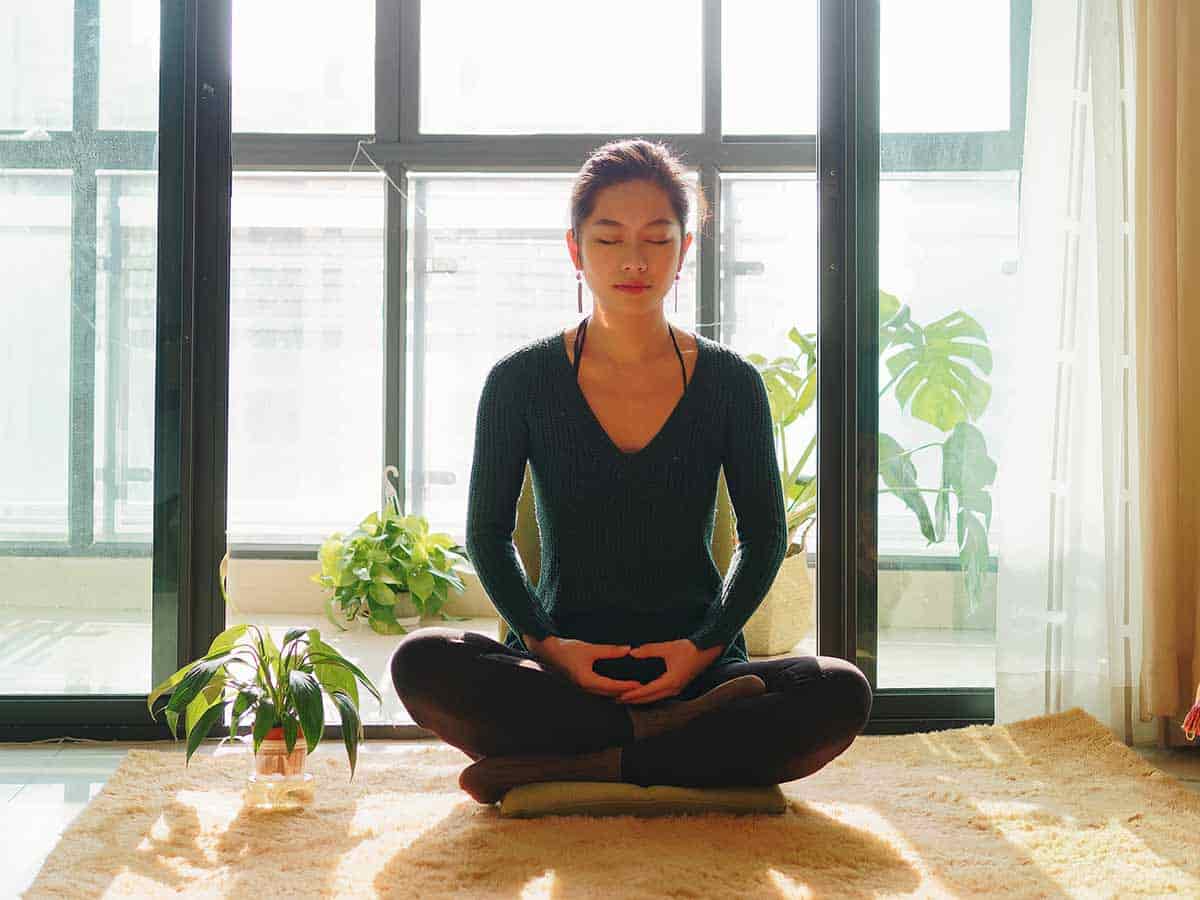Zen, meaning concentration in Japanese, is a form of meditation practiced by millions of people around the world, including non-Buddhists. As with any meditative platform, there is a technical and structural aspect to Zen meditation that must be properly executed in order to get the desired mental, emotional, and spiritual results, and it all starts with getting into the proper meditative posture.
The posture that most followers of Zen meditation take when they meditate is called Zazen. It is actually a collection of sitting positions that include the following:
- Full lotus
- Half-lotus
- Burmese
- Among others
All Zazen postures emphasize proper body position and breathing to unify the mind and body.
Zen meditation offers untold benefits to those who embrace its teachings and practices. But to tap into the restorative and healing powers of Zen meditation, you must first master the fundamentals. Ready to get started? Your Zen meditation journey begins with understanding and executing Zazen posture, so read on to learn what it is and how to do it properly.
Table of Contents
Why is Posture Important in Zen Meditation?
As its proponents and enthusiasts can attest, Zen meditation is a highly technical practice. Just as you must learn to walk before you can run, so too must you be able to achieve proper posture before you can meaningfully participate in Zen meditation and reap its life-changing benefits.
The main purpose of getting into the right posture is to promote a heightened sense of concentration. In fact, the word Zen comes from the Chinese term “Chan,” which derives from the ancient Indian word “Dhyana,” meaning “concentration.” Along the same line, practicing proper Zen meditation posture allows you to achieve a higher level of mindfulness, the ability to focus the mind on the here and now.
Having a good posture for Zen meditation goes far beyond simply sitting up straight and not slouching. It requires orchestrating various parts of the body, including the head, neck, and even the eyes. Only by synchronizing the entire body to get into the right posture can you achieve the proper physical platform that allows the mind to enter into the right state for a fully immersive session of Zen meditation.
How Do You get into Zazen Posture?
For 2,500 years, Zazen meditation has transformed the minds and bodies of its multitude of followers seeking enlightenment.
On the surface, Zazen refers to any seated posture in Zen meditation. But as a hallmark collection of positions not just within Zen meditation but in all meditative arts, its significance runs deep. In fact, Zazen’s posture embodies the essence of Zen meditation and all of its teachings.
If you are new to Zen meditation, getting into Zazen posture can be difficult as you will be placing parts of your body into unfamiliar (and physically challenging) positions. But by following these steps, you can learn the fundamentals of Zen meditation’s most important posture and be on your way to achieving inner peace and enlightenment.
There are five primary seated positions in Zen meditation that can be called Zazen posture, and they all mimic the seated Buddha. Four out of these five postures require sitting on the floor, and the use of a small pillow known as a zafu can be an important aid in achieving proper positioning by elevating the hips and pelvis and pitching them forward just enough so that your knees can rest on the ground.
Here is a detailed look at each Zazen posture, including how to get into them:
Burmese Position
This is the simplest of the floor-seated positions and the most straightforward in terms of body positioning. This Zazen posture is achieved by:
- Sitting with your buttocks on the front third of the zafu so that your pelvis is pitched slightly forward
- Both of your knees should rest on the floor, as should your feet
- If you are a beginner, you may find that tightness in your leg muscles prevent your knees from touching the ground; through repetition, your muscles will eventually loosen up, and your knees will reach the floor in no time
- Achieving an upright body position is important and can be achieved by straightening your back (imagine the top of your head pointing straight up at the ceiling), pushing your stomach out a bit, and arching your lower back slightly
Once you master the Burmese posture, you can move on to the slightly more difficult half lotus and full lotus positions.
Half-Lotus Position
This Zazen posture is similar to the other floor-seated positions in that there are three points of contact with the floor: the buttocks and both knees. This arrangement essentially forms a tripod, which provides a stable base for Zen meditation.
Here is what you need to know about the half-lotus position:
- Both knees are on the floor
- The left foot is placed on top of the inner right thigh while the right foot lies flat on the ground
- Because only one foot is on the floor, this posture is asymmetrical and does require a conscious effort to maintain a straight upper body position
If the half-lotus position suits you, it would be a good idea to alternate the foot that is elevated on the opposing thigh each time you meditate to ease the strain on your upper body.
Full Lotus Position
The full lotus is the penultimate Zazen posture and emblematic not only of Zen meditation but of all meditative arts. Here are a few pointers on how to get into the full lotus position:
- For this position, you will be seated on the floor (or on a zafu) with your knees resting on the ground
- Each foot is placed on the opposing inner thigh (e.g., right foot on the left thigh and the left foot on the right thigh)
- The full lotus requires the greatest amount of flexibility to achieve, so stretching before each Zen meditation session may be needed to get into position
The full lotus is by far the most challenging position to master, but this well-known Zazen posture is also the most stable and symmetrical, so it is worth the effort to learn.
Seiza Position
Where the Burmese, half lotus, and full lotus are variations on sitting cross-legged, the seiza Zazen meditation posture is essentially a kneeling position where your knees are in front of you, and your feet are behind you.
There are three ways to assume the seiza position for Zen meditation:
- The first way is by simply sitting with your buttocks on your heels (this is also the most difficult and potentially uncomfortable seiza position to assume)
- The second way is to place a cushion or pillow on your upturned feet to make the kneeling more comfortable on your knee joints and your ankles
- The third way to get into the seiza position is to sit on a seiza bench, which is a small bench-like wooden structure that goes between your buttocks and your calves and upon which you can sit so that none of your body weight is on your feet or ankles
As with the other Zazen sitting postures, proper upper body positioning is important for achieving the physical and mental stability necessary for fully immersive Zen meditation.
Chair Position
For those practitioners for whom sitting cross-legged or kneeling on the floor is simply not feasible or comfortable for the duration of a Zen meditation session, the final Zazen posture is the chair position. This chair-seated position is perfectly suitable for Zen meditation, but as with the floor-seated postures, there are several important things to keep in mind, including:
- It is best to sit forward in the chair (even if you are using a cushion or zafu) to maintain the ideal spine angle
- Your feet should be flat on the ground (so the chair height does matter)
- If possible, avoid leaning back in the chair (but if you must, due to back issues, place a pillow between your back and the back of the chair to create some spacing)
Just because you are seated in a chair does not mean that proper body position is not important, nor is the intent behind sitting in a chair to make Zen meditation easier or more comfortable. As with all the Zazen postures, the idea is to provide a solid body structure to allow the mind to focus.
Zazen Posture Tips
Aside from the physical positions themselves, there are other aspects of Zazen posture that are important to keep in mind, including:
- Hand position – known as mudras, there are a number of hand positions associated with Zazen posture, such as laying them on your thighs with the palms facing up
- Breathing – this is another important aspect of Zazen posture, and the key is to maintain a natural, flowing rate of breathing while focusing on the present throughout the session
- Focus – maintaining your focus and concentration can be a challenging aspect of Zen meditation, and one helpful tip is to set yourself up facing a wall so as to minimize any visual distractions
One way to view Zazen posture is by accepting it as a means to an end. By making an effort to learn the positions properly, you will set yourself up for meditative success (i.e., enlightenment) down the line.
When Did Zazen Meditation Posture First Begin?
The concept of meditation is thousands of years old, and scholars believe that the very first forms may date as far back as 1500 BCE. As far as Zazen meditation is concerned, its roots can be traced to The Buddha, who lived over 2600 years ago and whose transformative teachings include the practice of mindfulness and meditative awareness.
In the 7th century, a Japanese monk named Dosho returned to Japan after learning Buddhism under the tutelage of Chinese grandmaster Hsuan Tsang. Dosho developed his own school of meditative arts featuring sitting postures. This came to be known as Zazen meditation, and many centuries after its creation, it has never been more popular.
How Long Do Most Zen Meditations Last?
According to most Zen meditation centers and schools, there is no strictly prescribed amount of time that meditative sessions must last. For most practitioners, there is a certain amount of time needed just to get into proper Zazen posture and reach a focused, relaxed state of mind.
While for some, sessions ranging from 30 to 45 minutes is the norm, there is also a school of thought advocating that it is the incorporation of Zen meditation as a regular part of your daily routine, and not necessarily the length of time meditating during each session, that is the most important thing to accomplish. By this logic, even 5 to 10 minutes would suffice so long as it is done consistently (e.g., every day).
How Do I Get Started with Zen Meditation?
Zen meditation is fittingly referred to as “thinking about not thinking,” meaning that it is a practice that seeks to achieve a reflective state of awareness, not about anything in particular but in a broad, general sense. With its emphasis on proper positioning in Zazen posture, Zen meditation is not for everyone.
To get started with Zen meditation, there are many options and a wealth of available resources, including:
- Audio programs
- Books
- Buddhist temples
- Digital content (on-demand and streaming)
- In-person classes
- Online programs
- Zen meditation retreats
Once you find the right class or setting for getting started with Zazen meditation, it is important to stay grounded and remember that the reward lies in the journey and not the destination.
Conclusion
Not only is Zazen posture the foundation upon which all of your Zen meditation techniques can be laid, but in a broader sense, it can also serve as a road map to guide you on your lifelong journey of self-awareness and self-improvement.
Check out this article for reasons why you should go on a meditation retreat.




